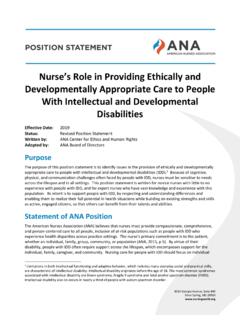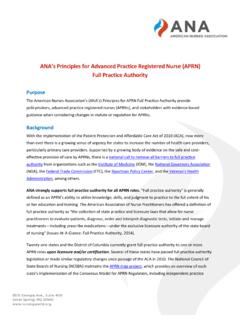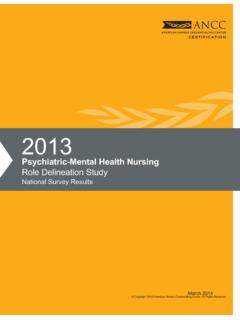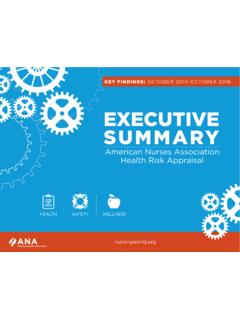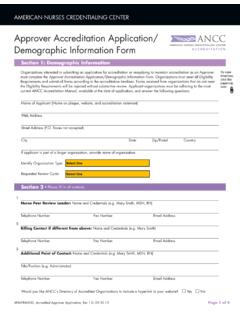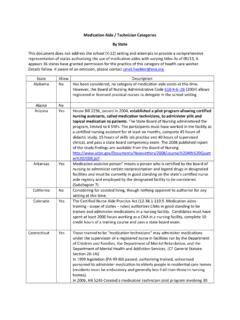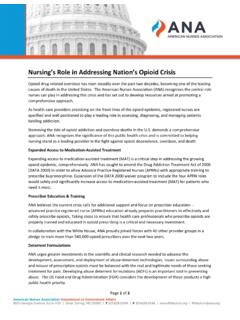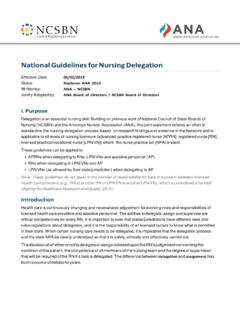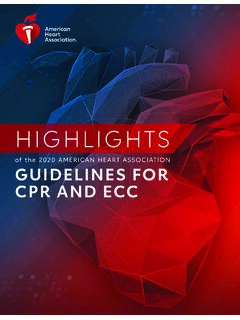Transcription of Nurses’ Roles and Responsibilities in
1 8515 Georgia Avenue, Suite 400 Silver Spring, MD 20910 Nurses Roles and Responsibilities in Providing Care and support at the End of life Effective Date: 2016 Status: Revised Position Statement Written by: ANA Center for Ethics and Human Rights Adopted by: ANA Board of Directors Purpose The purpose of this ANA position statement is to articulate the Roles , Responsibilities , and opportunities for nurses providing care for patients at the end of their lives, and for their families. This statement also provides direction for nurses to support patients and families in recognizing and adapting to a patient s impending death. Nurses are responsible for recognizing patients symptoms, taking measures within their scope of practice to administer medications, providing other measures for symptom alleviation, and collaborating with other professionals to optimize patients comfort and families understanding and adaptation. Statement of ANA Position Nurses are obliged to provide comprehensive and compassionate end-of- life care.
2 This includes recognizing when death is near and conveying that information to families. Nurses should collaborate with other members of the health care team to ensure optimal symptom management and to provide support for the patient and family. Nurses and other health care providers have a responsibility to establish decision-making processes that reflect physiologic realities, patient preferences, and the recognition of what, clinically, may or may not be accomplished. Establishing goals of care for this patient at this time may provide a framework for discussion about what care should be provided. This process often involves collaboration with experts in decision-making, such as ethics committees or palliative care teams. Recommendations Over the past twenty years, much has been learned about how end-of- life care can be improved. Opportunities still abound for nurses and other health care providers to continue to advance the care for patients and families. In an IOM report, authors wrote, At present, the health care system is ill designed to meet the needs of patients near the end of life and their families.
3 The system is geared to providing acute care aimed at curing disease, but not at providing the comfort care most people near the 8515 Georgia Avenue, Suite 400 Silver Spring, MD 20910 Page | 2 end of life prefer. The financial incentives built into the programs that most often serve people with advanced serious illnesses Medicare and Medicaid are not well coordinated, and the result is fragmented care that increases risks to patients and creates avoidable burdens on them and their families (Institute of Medicine, 2014, p. 330). Recommendations for improvements in practice, education, research, and administration listed here are steps that nurses can take to overcome some of these barriers. Practice 1. Strive to attain a standard of primary palliative care so that all health care providers have basic knowledge of palliative nursing to improve the care of patients and families. 2. All nurses will have basic skills in recognizing and managing symptoms, including pain, dyspnea, nausea, constipation, and others.
4 3. Nurses will be comfortable having discussions about death, and will collaborate with the care teams to ensure that patients and families have current and accurate information about the possibility or probability of a patient s impending death. 4. Encourage patient and family participation in health care decision-making, including the use of advance directives in which both patient preferences and surrogates are identified. Education 1. Those who practice in secondary or tertiary palliative care will have specialist education and certification. 2. Institutions and schools of nursing will integrate precepts of primary palliative care into curricula. 3. Basic and specialist End-of- life Nursing Education Consortium (ELNEC) resources will be available. 4. Advocate for additional education in academic programs and work settings related to palliative care, including symptom management, supported decision-making, and end-of- life care, focusing on patients and families. Research 1.
5 Increase the integration of evidence-based care across the dimensions of end-of- life care. 2. Develop best practices for quality care across the dimensions of end-of- life care, including the physical, psychological, spiritual, and interpersonal. 3. support the use of evidence-based and ethical care, and support decision-making for care at the end of life . 4. Develop best practices to measure the quality and effectiveness of the counseling and interdisciplinary care patients and families receive regarding end-of- life decision-making and treatments. 5. support research that examines the relationship of patient and family satisfaction and their utilization of health care resources in end-of- life care choices. Administration 1. Promote work environments in which the standards for excellent care extend through the patient s death and into post-death care for families. 2. Encourage facilities and institutions to support the clinical competence and professional development that will help nurses provide excellent, dignified, and compassionate end-of- life care.
6 8515 Georgia Avenue, Suite 400 Silver Spring, MD 20910 Page | 3 3. Work toward a standard of palliative care being available to patients and families from the time of diagnosis of a serious illness or an injury. 4. support the development and integration of palliative care services for all in- and outpatients and their families. Background The proximal reality of a patient s death is typically very difficult for patients and families. Choices about the most appropriate health care at the end of a person s life often address whether specific treatments are ultimately likely to benefit the patient. These choices may have a quality-of- life dimension. Nurses are frequently in a position to provide guidance for patients and families confronting difficult decisions and adapting to painful realities. It is not uncommon for a patient s death to follow the withdrawal of potentially life -prolonging therapies ( , ventilator support , dialysis, vasopressors or inotropes, chemotherapy, antibiotics, etc.)
7 There is no ethical, moral, or legal difference between stopping a therapy and never starting it. Providers should never start a therapy they are not willing to discontinue. Decisions about care at the end of a person s life often involve quality-of- life considerations. Nurses are obligated to provide care that includes the promotion of comfort, relief of pain and other symptoms, and support for patients, families, and others close to the patient. Throughout this position statement, the term family includes those linked by biology or affection; family is whomever the patient says it is. While nurses should make every effort to provide aggressive symptom management at the end of life , it is never ethically permissible for a nurse to act by omission or commission, including, but not limited to, medication administration, with the intention of ending a patient s life . Decision-making for the end of a patient s life should occur over years rather than just in the minutes or days before a patient s death.
8 Nurses can be a resource and support for patients and families at the end of a patient s life and in the decision-making process that precedes it. Nurses are often ideally positioned to contribute to conversations about end-of- life care and decisions, including maintaining a focus on patients preferences, and to establish mechanisms to respect the patient s autonomy. There are times when the preferences of the family do not represent, or are in conflict with, the preferences of the patient. In those cases, the nurse s primary responsibility is to provide care and support to the patient and to respect the patient s autonomy while continuing to support the family as they struggle to adjust to the impending reality of the patient s death. Standards for excellent care for patients at the end of life should be evidence based, and should integrate national and international standards of care. History/Previous Position Statements 2010 Position Statement: Registered Nurses Roles and Responsibilities in Providing Expert Care and Counseling at the End of life 2003 Position Statement: Pain Management and Control of Distressing Symptoms in Dying Patients 1994 Position Statement: Active Euthanasia 1994 Position Statement: Assisted Suicide 1991 Position Statement: PSDA (Patient Self-Determination Act) 8515 Georgia Avenue, Suite 400 Silver Spring, MD 20910 Page | 4 Supportive Material Code of Ethics for Nurses with Interpretive Statements ( 2015 ): Provision 1, Interpretive Statement , titled The Right to Self Determination, affirms the nurse s role and responsibility in providing care and support at the end of life .
9 The importance of carefully considered decisions regarding resuscitation status, withholding and with-drawing life -sustaining therapies, forgoing nutrition and hydration, palliative care, and advance directives is widely recognized. Nurses assist patients as necessary with these decisions. Nurses should promote advance care planning conversations and must be knowledgeable about the benefits and limits of various advance directive documents. The nurse should provide interventions to relieve pain and other symptoms in the dying process consistent with palliative care standards and may not act with the sole intent of ending a patient s life (p. 3). Similarly, Nursing s Social Policy Statement: The Essence of the Profession (2010) states: All registered nurses are educated in the art and science of nursing, with the goal of helping individuals, families, groups, communities, and populations to promote, attain, maintain, and restore health or to experience a dignified death (p.)
10 19). This position statement also builds on the following ANA and HPNA documents and position statements: Nursing: Scope and Standards of Practice ( 2015 ) Palliative Nursing: Scope and Standards of Practice: An Essential Resource for Hospice and Palliative Nurses (2014) Position Statement: Forgoing Nutrition and Hydration (2011) Position Statement: Nursing Care and Do Not Resuscitate (DNR) and Allow Natural Death (AND) Decisions (2012) Nurses Roles and Responsibilities for care at the end of life are grounded in the fundamentals of excellent practice and clinical ethics. Respect for patient autonomy is an important dimension of clinical decision-making, including at the end of life . While often rewarding, care of patients and families when a person is dying is demanding work that requires the nurse to marshal professionalism and compassion while honoring the nurse s personal integrity. Guidance and support for Patients and Families at the End of life Nursing care includes not only disease management but also attention to physical comfort, and the recognition that patients well-being also comprises psychological, interpersonal, and spiritual dimensions.
